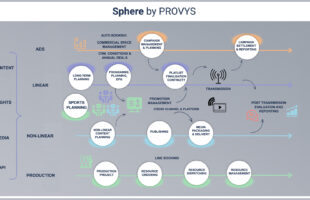the region’s broadcasters continue to focus on building a diverse portfolio to target wider audiences. For the viewer, more channels means more choice, and no longer does the television schedule have to be ‘one size fits all’. With the introduction of TIVO/PVRS, viewers have the option to watch what interests them all day every day, rather than being dictated to by schedulers. According to Andrew Carter, national tactical planning director, MindShare China, for all television channels to maintain their engagement factor, they have to continue to diversify to keep pace with their viewers’ needs and wants. “The explosion of digital has given the traditional broadcaster more opportunities to acquire new channels and therefore explore and test new programming on so-called ‘sister channels’ without damaging the core channel viewership with a more risk adverse strategy. This strategy allows certain styles of programmes to have a true acid test, and the potential to build up a cult following before they go mainstream,” said Carter. “Across the globe there are some clear success stories. Little Britain on BBC3 became a huge success before going mainstream on BBC1 and Two. For major sporting events such as the FIFA soccer World Cup, we have also seen specific examples of a broadcaster using its programming rights to the full, by placing smaller games with less audience on a sibling channel yet still carry a great male upmarket profile which will satisfy the advertisers’ needs. Therefore, the broadcaster offers a complete service without disrupting the main schedule and the masses,” pointed out Carter. According to Kenneth Tsang, managing director, Initiative Singapore, “What the cable TV guys are doing is exactly how major marketing companies grow their business – they put out multi-brand strategy to cover as much of the market. Similarly, they practise a multi-channel strategy. The key is: whether the segments each channel covers is adequately large to attract the revenues needed. The viewer today makes this business model possible because they have increasingly sophisticated lifestyles.” When asked to comment on gender specific channels, Tsang said rather than any gender specific channels in pan Asia, there are more interest-based channels. “There is however, a fairly new channel – FX channel that is skewed to males, owned by Fox,” he said. With sophisticated lifestyles, is such content needed for new platforms such as IPTV and mobile? On the same, he said, “IPTV and mobile TV are just distribution channels with a difference in that you could watch it from a mobile source. These may well boost TV viewing in general and offer the opportunity for more channels to open.” How attractive are they to advertisers? From an advertising and sponsorship standpoint, the criteria an agency like Initiative uses is less of reach and big numbers, and more to do with content relevance and affinity to the specific groups of consumers. “Advertising is also a lot cheaper when big numbers are no longer in play. So for the advertiser it is of mutual benefit – higher connectivity with the consumer, and lower prices,” said Tsang, who added that the agency considers product placement or any other form of non- traditional TVC way to associate brands for such channels. “The proliferation of channels makes this area very exciting.” For his part, Carter says, “From an advertising perspective, if more channels are made available, this will lead to an increase in supply, thus reducing overall television inflation. Television has historically been used by advertisers as a way of reaching large numbers with a higher level of wastage versus other media. With the introduction of more bespoke channels, this will offer the chance for brands to be more focused on targeting, albeit with less numbers, however less wastage.” He added, “Furthermore ‘sister channels’ or more bespoke channels will enable advertisers with smaller budgets to try TV versus other media.” “To make the channel work for viewers and advertisers then the channel must offer a differentiation versus the norm, but yet engaging with enough quality content which will keep the viewer satisfied for shorter periods of time than the flagship channels. Advertisers are constantly challenging agencies to deliver more targeted campaigns, particularly with younger and up-market viewers migrating into other media. It’s imperative that a broadcaster has the flexibility and is agile enough to demonstrate that across its portfolio of broadcast streams it can target all potential consumers across the varying times and platforms. No longer will the viewer be tied to a daypart or day of week,” he said. “If successful, then they do offer a fantastic opportunity either via sponsorship or continued frequency of spots. Just placing spots is an easy fix; however the real skill is developing the content with the channel which suits broadcaster, advertiser and viewer. If successfully implemented using secondary more bespoke channels can add real value versus your normal route, adding light television viewers and ultimately building effective reach in a cost efficient engaging manner,” said Carter. He further added, “A new channel launch is never a guaranteed success because it’s new, it has to have a solid level of funding to support its content and marketing, furthermore the level of content has to be consistent not just the first two weeks of really hot programming then all down hill. Advertisers and agencies don’t expect the niche channels to replace the traditional, they should both work together ensuring your total communication is becoming more cost effective and more targeted.” Broadcasters’ verdict Be it the legacy of a flagship brand or specialisation in a certain genre, there are certain factors which a broadcaster takes into consideration before expanding their operations. For a group like Discovery Networks, its Asia Pacific network comprises seven non-fiction factual and lifestyle brands. The only exception in terms of a channel not carrying the Discovery name is Animal Planet. Reflecting on the strategy behind such wide variety, Tom Keaveny, executive vice president and managing director, Discovery Networks Asia-Pacific told Television Asia Plus, “We have built a strong, balanced Discovery portfolio that is synonymous with curiosity and quality entertainment. Of course, one of the key considerations is ensuring any new brand we launch reflects the qualities of what Discovery stands for (programming that entertains and informs).” At the same, a broadcaster like Discovery has to ensure that viewers know which channels to tune in to for the types of programmes that appeal to their needs and interests. According to Sonia Jackson, senior vice president, marketing, National Geographic & FOX International Channels, South East Asia, a distinct and differentiated product from a recognisable and relevant brand name is critical to building a successful sub brand. A company like Comcast International Media Group specialises in “strongly themed channels” that address specific niche audiences. Its network portfolio includes brands like E! Entertainment (entertainment, celebrity and pop culture), The Style Network (for young women, relatable and inspiring lifestyle programming), The Golf Channel and programming from G4 (for those who love gaming, technology and gadgets) and Exercise TV (workouts, fitness trends and sports training from top instructors and trainers). Being an established distributor of branded lifestyle channels and programming, Christine Fellowes, managing director of Asia for Comcast International Media Group, says, “We understand that the imperative of branded television is to deliver a unique genre and attitudinal proposition to viewers with a voice and personality that speaks uniquely to them.” Specifically on gender-specific channels, she said, “Channels that appeal to a specific ethnic, interest or gender base like The Style Network, a popular female skewed channel, or G4, programming for young men who love gaming, gadgets and technology are appealing to advertisers who appreciate the efficiency of a targeted ad spend with little wastage. These along with E! and The Golf Channel that deliver strongly to a targeted audience are also sought after by operators who look to package themed genres together in content offerings to drive digital uptake.” CIMG believes the future is about entertainment brands rather than destination programming. “As new platforms offer viewers the choice to consume entertainment when and where they want, people will go to a brand that they trust will deliver value to them consistently. We know that young urban audiences who love celebrity gossip and entertainment news rely on E! for their ‘celebrity fix’. They know that E! is the authority in this genre and consistently deliver to their expectations on mobile, broadband or on television. The same goes for The Style Network for young women, The Golf Channel for golfers etc,” she added. On how sub-brands fit in with the overall multi-channel strategy, Jackson pointed out that there are distinct advantages to having more shelf space in the marketplace. “Besides assisting with the economics of each channel, in the bouquet, from a cost and revenue perspective and allowing us more opportunities to provide better value to our platform partners and advertisers, a broader palette of channels represents more choice and thus increases the odds of keeping viewers tuned into our brand. However, ultimately each channel has to stand on its own,” she said. Fellowes said, “What viewers care about, and I expect operators are seeing this, is choice and quality. The days when you can offer a bundle of sub-branded channels filled with little fresh or compelling content and a confusing brand proposition, are coming to an end. Subscribers don’t want to pay for excess channels that don’t deliver. And operators don’t want to use capacity on channels that are taking up shelf space and offering little when they are looking at priorities like VOD and HD. That said, the opportunity for themed niche brands in a digital future is exciting. Audiences want access to content that is specific to them, presented in a style that they relate to. And the chance to segment audiences by interest and demographic groups offers great potential to savvy programmers.” Discovery’s Keaveny, said, “There is a clear proposition – we can programme our channels to cater to that specific audience. Discovery Home & Health, for example, can have programming that specifically appeals to women and women’s lives, whether it’s about pregnancy or plastic surgery; we can track and monitor what our male audience enjoys watching most for Discovery Turbo. Our viewers understand what the channel offers because we are not trying to be everything to everyone. Discovery Channel however has a broad appeal and even though we have a slight male skew, it offers variety, covering a spectrum of different genres.” In terms of positioning these channels, Keaveny said each channel has specific content that appeals to different genres and viewer profiles. He said, “We have a strong portfolio of channels and I wouldn’t necessary call them “niche” given this doesn’t reflect their wide distribution. Discovery Travel & Living, for example, reaches 129 million households in Asia-Pacific alone, hardly a niche network; but it is our leading lifestyle channel, providing an in-home getaway with a diverse range of high quality programming on travel, food, design and décor. Animal Planet also has broad appeal and distribution to over 146 million homes in the region.” From revenue perspective, Jackson says in the early years, subscription revenue plays a key role for the new channels. As the channels reach a critical threshold with distribution and audience viewership, advertising revenue starts to play a contributing role alongside subscription. “In the long term, the channels look to achieving a fair balance across all platforms,” she added. Discovery’s Keaveny said: “We follow a dual revenue model incorporating both advertising and affiliate revenue and ensure it makes good business sense to launch new channels – we wouldn’t do it otherwise. Having a strong presence in the region, and providing viewers with various ‘touchpoints’ to Discovery is key – and we are able to leverage our own platform to cross-promote and keep the audiences within the Discovery portfolio. We do evaluate each market in the region separately however, for an optimum mix of networks.
Ad – Before Content
Related Articles
ZEE5 Global and Jio Studios unite to bring blockbusters Hisaab Barabar and Mrs. to OTT Screens
- Latest Movies and Series Premiering on MAX this January
An unrivalled and highly elusive lone assassin, the Jackal, (Eddie Redmayne) makes his living carrying out hits for the highest fee. But following his latest kill, he meets his match in a tenacious British intelligence officer (Lashana Lynch) who starts to track down the Jackal in a thrilling cat-and-mouse chase across Europe, leaving destruction in its wake.
Keshet International sells Tuesday’s Child TV’s The Hit List to M6 Groupe in France
Glensound Debuts European Parliamentary Broadcast System at ISE 2025
- PROVYS Technologies Reports an Active and Successful 2024
Screenshot
ZEE5 Global announces the World Digital Premiere of The Sabarmati Report








